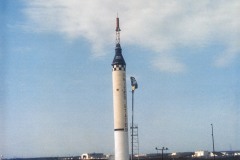Mercury-Redstone 1 (MR-1) was the first unmanned Mercury-Redstone flight test as part of Project Mercury and the first attempt to launch a Mercury capsule using the Redstone launch vehicle. It was intended as an unmanned suborbital spaceflight and was launched on November 21, 1960 from Cape Canaveral, Florida.
The rocket was fully assembled on the launch pad and the countdown proceeded normally until the main engines started. The engine fired, but it immediately failed again because a cable had not separated properly from the rocket. The rocket rose about 10 cm from the ground and fell back into the support frame. Then the rescue tower started, as it was the next step in the planned flight program. Three seconds later, first the smaller release parachute and then the main parachute flew out of the top of the Mercury landing capsule, which then hung down on the rocket.
Despite this failure, the rescue system proved to be successful and valuable results were gained from this breakdown.
However, the replacement mission, Mercury-Redstone 1A (MR-1A), using the same space capsule (Mercury spacecraft #2), went smoothly on December 19, 1960. The spacecraft reached an altitude of around 210 km and was recovered from the Atlantic by a helicopter 15 minutes later after landing.
Mission data |
|
|---|---|
Mission |
Mercury-Redstone 1 (MR-1) |
Rocket |
Redstone MRLV, MR-1 |
Spacecraft |
Mercury capsule #2 |
Launch date |
November 21, 1960 |
Launch site |
Launch Complex 5 (LC-5), Cape Canaveral, Florida |
Mission duration |
2 sec |
Altitude |
10 cm |
Distance |
– |
Velocity |
– |
Max G |
– |



